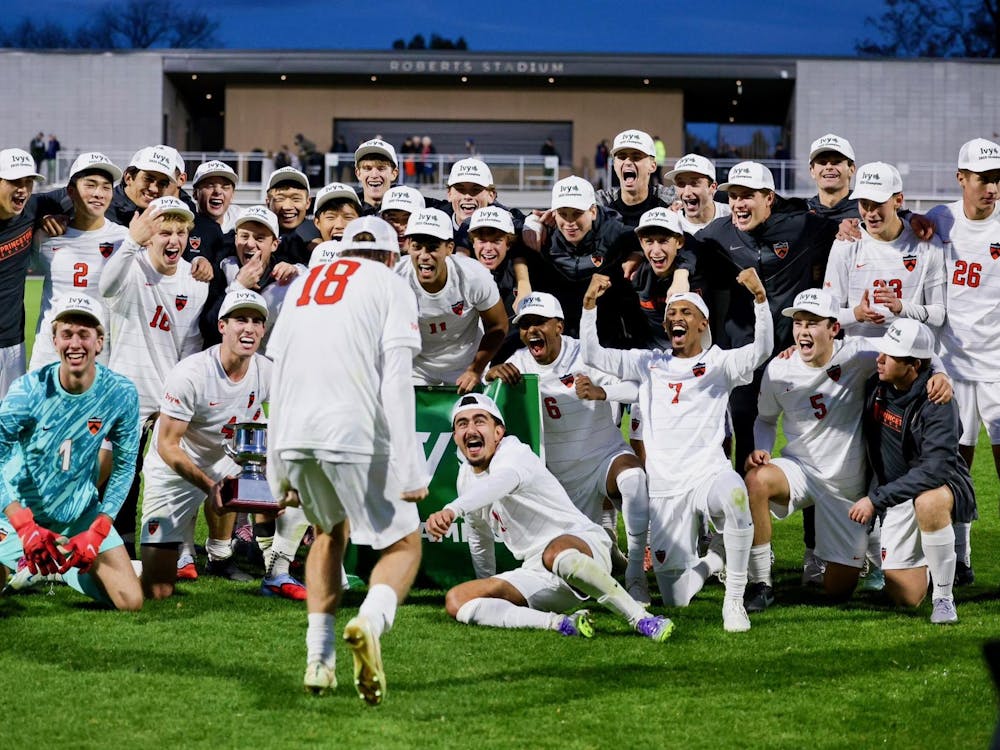After the varsity team moved to Jadwin Gymnasium in 1969, Dillon became just another gym, having lost its grandeur and status on the national basketball stage. Following its tenure as host to nationally ranked college basketball teams, however, Dillon took on perhaps an even more demanding task: pickup basketball.
Walk into the gym any time after classes have ended for the day, and you’re likely to hear the chorus of basketballs bouncing on hardwood, of squeaking shoes, yells of “screen right” and “shot” ringing across the court. Welcome to Dillon hoops.
To those unfamiliar with this phenomenon, it happens like this. One guy gets bored and comes to the gym to shoot around; soon, a group of friends looking to get some exercise comes and plays some three on three; then another and another, and soon 10 have gathered on the court.
Ball up.
“I just like playing basketball, plus it’s great exercise,” freshman Anna Zhao said. “At the same time, I get to meet a lot of cool people I wouldn’t normally get to meet around campus.”
One of the amazing things about pickup is its order and efficiency. The rules of the court have never been written down, and yet everybody knows them. The first 10 to gather on a court get to play. The first game of the day is always a game to 15, win by two, with field goals counting as one point and three-pointers counting for two. After the initial game, the winning team stays to take on the next five that are waiting, with games to 12, win by two. Fouls are called and respected, but there are no such things as foul shots. Officiating is strict: traveling, double dribble, carry, up and down — all the regularities of basketball apply. The game never loses its rhythm.
Pickup ball — like work, like life, like parties — has a logical lifespan. The game is dead in the early hours of the morning. From the time the gym opens till three in the afternoon, hardly a soul can be found shooting baskets. People begin to trickle in around four, and play continues till six, seven or eight, depending on the night. After dinner, the action resumes until the gym closes long after midnight.
“In some ways, playing ball at Dillon was what college was all about for me,” Ed Hoa ’08 said. “I can work until 11 p.m. and still head over to the gym to play pickup with friends.”
To the extent that pickup ball serves as a central pillar of student life at Princeton, some graduates have found that Dillon basketball is an indispensable part of the undergraduate experience. Upon being asked what life at Princeton would have been like without pickup ball at Dillon, Hoa gave a most sincere answer:
“It would be like the working world.”
Those who finally earn their degree and walk away from Nassau Hall often find it difficult to leave the court that they’ve called home for four years.
“What I loved most about Dillon was the feeling of complete freedom on the court,” Odie Ayaga ’08 said. “It didn’t matter when my thesis was due or that I had a paper due the next day. All that mattered at that moment was the court and the game.”

It’s about more than escaping from the day-to-day pressure of being a Princeton student, though.
“Dillon’s a unique place on campus in that you meet people who become great friends … from all different backgrounds, whether they be from the Township, undergrads or grad students,” Ayaga said. “It’s like the melting pot of the University.”
Like Bradley and other stars enshrined in Princeton varsity athletic history, Dillon greats also maintain their places in Princeton lore. Though their jerseys may not hang from the rafters, and their numbers aren’t retired, the legends of Dillon pickup are remembered in the minds of the next generation that graces the main Dillon floor.
Dillon is where the infamous baby hook was perfected by Tom Feng ’08. It is where one Karl Micka-Foos ’08, former sports editor for The Daily Princetonian, drained long, arcing threes from deep behind the three-point line to seal countless games. Dillon is where reputations are made, where legends are born and where on Thursday nights the Street comes second to “first to 15 by two.”
More than 40 years after Bradley and co. ruled Dillon, an observer walking into the gym would notice that very little has actually changed from those golden days of Princeton basketball. Though the hardwood now plays host to much lesser names, basketball in Dillon retains its intensity, its competitiveness, its rules, its fire and its electrifying fast breaks.
Basketball will always be basketball, and as all Tigers know, there’s always a game waiting at Dillon.
Ball up.







